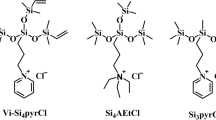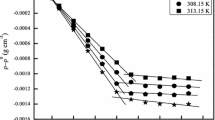Abstract
Mixtures of trisiloxane type nonionic silicone surfactant (SS) with sodium dodecylsulfate, tetradecyltrimethylammonium bromide or tert-octylphenol ethoxylated with 9.5 ethylene oxide groups were studied in water at 30 °C by dilute aqueous solution phase diagrams, surface tension and dilute solution viscosity methods. The cloud points for the silicone surfactant aqueous solutions increased upon addition of hydrocarbon surfactants indicating the formation of hydrophilic complexes in mixture solutions. The scrutiny of the surface tension isotherms plotted as a function of SS concentration revealed that competitive adsorption effects are the characteristic features in these mixtures depending upon the SS concentration. Otherwise the isotherms exhibited two break points and the difference of concentration between the two break points increased with the increase in SS concentration indicating the cooperative nature of interactions. The micellar mole fractions of individual surfactants were determined by Rublingh's regular solution theory; interaction parameters and activity coefficients were evaluated and interpreted in terms of synergistic type interactions in these mixtures. The surface active parameters in mixture solutions were estimated and their analysis shows that the molecular species in the mixture solutions have a preferential tendency for adsorption at the air/water interface than in association form in the bulk solution. The effect of hydrocarbon surfactants on the intrinsic viscosity of SS micelles was monitored and related to the enhanced hydration in mixed micelles.






Similar content being viewed by others
References
Hill RM (2002) Silicone siloxane surfactants. In: Meyers R (ed) Encyclopedia of polymer science and technology, 3rd edn. Academic Press, San Diego, pp 793–804
Hill RM et al (2002) Silicone surfactants—new developments. Curr Opin Colloid Interface Sci 7:255–261
Hill RM (1999) Silicone surfactants. Marcel Dekker, New York
Schlachter I, Faldmann, Krane G (1998) Silicone surfactants In: Holmberg K (ed) Novel Surfactants vol 74, pp 201–224
Kuneida H, Uddin M, Horii M, Furukawa H, Harashima A (2001) Effect of hydrophilic—hydrophobic chain lengths on the phase behavior of A–B type silicone surfactants in water. J Phys Chem B 105:5419–5426
Wagner R, Strey R (1999) Phase behavior of binary water—trimethylsilane surfactant systems: origin of the dilute lamellar phase. Langmuir 15:902–905
Stuermer A, Thunig C, Hoffmann H, Gruening B (1994) Phase behavior of silicone surfactants with comblike structure in aqueous solution. Tenside Surfactant Deterg 31:90–98
Kunieida H, Taoka H, Iwanger T, Harashima A (1998) Phase behavior of polyoxyethylene trisiloxane surfactant in water and water–oil. Langmuir 14:5113–5118
Ahn S, Alexandridids P (2001) Phase behavior and structural characterization of trisiloxane surfactant—water—silicone oil systems. Polymer Prepr 42:169–170
Gradzielski M, Hoffmann H, Robsich P, Ulbricht W (1990) The aggregation behavior of silicone surfactant aqueous solutions. Tenside Surfactants Deterg 27:366–379
Soni SS, Sastry NV, Aswal VK, Goyal PS (2002) Micellar structure of silicone surfactants in water from surface activity, SANS and viscosity studies. J Phys Chem B 106:2606–2617
Soni SS, Sastry NV, George J, Bohidar HB (2003) Dynamic light scattering and viscosity studies on the association behaviour of silicone surfactants in aqueous solutions. J Phys Chem B 107:5382–5390
Soni SS, Sastry NV, Joshi JV, Seth E, Goyal PS (2003) Study on the effect on nonelectrolyte additives on the phase, thermodynamics and structural changes in micelles of silicone surfactants in aqueous solutions from surface activity, small angle neutron scattering and viscosity measurements. Langmuir 19:6668–6677
Hill RM (1992) Interaction between siloxane surfactants and hydrocarbon surfactants. ACS Symp Ser 501:278–286
Sastry NV, Hoffmann H (2004) Interaction of amphiphilic block copolymer micelles with surfactants. Colloids Surf A 250:247–261
Walderhaug H, Knudsen KD (2008) Microstructures in aqueous solutions of a polyoxyethylene siloxane surfactant and a cosurfactant studied by SANS, NMR and self diffusion. Langmuir 24:10637–10645
Sastry NV, Punjabi SH, Aswal VK, Goyal PS (2012) Small angle neutron scattering, viscosity measurements on silicone, ionic and non-ionic surfactant mixed systems in aqueous solutions. J Dispersion Sci Technol 33:245–253
Alexandridis P, Athanassiou V, Fukuda S, Hatton TA (1994) Surface activity of poly(ethylene oxide)-block-poly(propylene oxide)-block-poly(ethylene oxide) copolymers. Langmuir 10:2604–2612
Holland PM, Rubingh DN (1983) Nonideal multi-component mixed micelle model. J Phys Chem 87:1984–1990
Clint JH (1975) Micellization of mixed nonionic surface active agents. J Chem Soc 71:1327–1334
Rosen MJ (1989) Surfactants and interfacial phenomena. Wiley, New York
Azzam EMS (2007) The synergism effect between sodium dodecylbenzene sulfonate and a block copolymer in aqueous solution. J Surfactants Deterg 10:13–19
Gentle TE, Snow SA (1995) Adsorbtion of small silicone polyether surfactants at the air/water interface. Langmuir 11:2905–2910
Acknowledgments
The authors are thankful to the Board of Research in Nuclear Science, Department of Atomic Energy, Mumbai for providing financial support under grant No. 2006/37/4/BRNS/893 and University Grants Commission, New Delhi for financial support under a major research project no. F. 40-94/2011 (SR).
Author information
Authors and Affiliations
Corresponding author
About this article
Cite this article
Sastry, N.V., Thummar, A.D. & Punjabi, S.H. Mixed Micelles of Trisiloxane Based Silicone and Hydrocarbon Surfactants Systems in Aqueous Media: Dilute Aqueous Solution Phase Diagrams, Surface Tension Isotherms, Dilute Solution Viscosities, Critical Micelle Concentrations and Application of Regular Solution Theory. J Surfact Deterg 16, 829–840 (2013). https://doi.org/10.1007/s11743-013-1435-7
Received:
Accepted:
Published:
Issue Date:
DOI: https://doi.org/10.1007/s11743-013-1435-7




